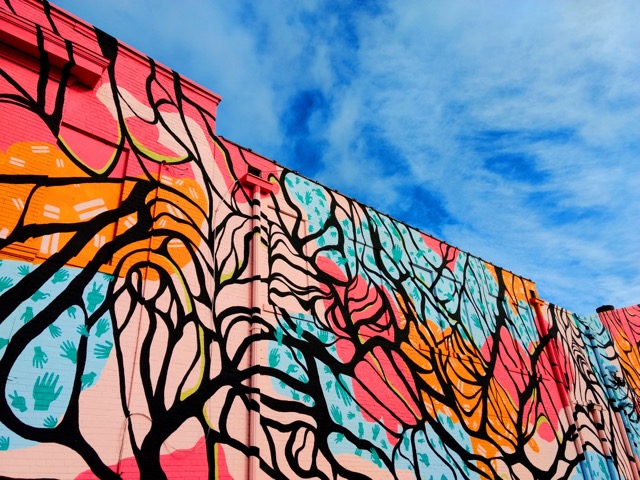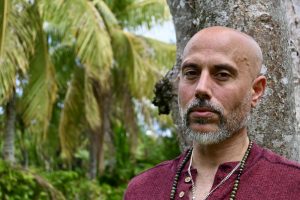
Appears in The Wayfarer, Autumn/Winter Issue 2022 | Visit Store»
Crisis of Education: Childhood in the Age of Loneliness
Contemplative Column by Theodore Richards
From the melting polar caps to violence in our cities to the rise of fascist governments, ours is an age in which we seem to be able to agree on almost nothing—except that we are in crisis. It would be easy to think of the rising anxiety I’m feeling as something different from the rising sea levels, or to think of the migrant crisis as at odds with the violence in our inner cities. But at the core, all of our crises actually share some of the same roots, and part of the healing process individually involves getting to those roots collectively.
A climate of loneliness that has taken over the planet—a planet of shrinking resources, imagination, hope. But how can we be hopeful when news of our demise comes on the television every night? How can we learn to share our resources when we are told that we can only find meaning by consuming more and more? Most significantly, how can we live as though the planet itself is a single, interconnected community when we have been told that our purpose is to find only individual success, only individual salvation?
Our spiritual malaise—the loneliness and loss of meaning—is connected to our ecological, political, and economic crises. It’s all connected; and it’s all about the deep story we tell about who we are and our place in the world. And this all comes down to how we educate our children.
Let me explain.
There’s something in the air, as thick and unmistakable as the CO2 particulates, even if it isn’t as easily quantified. All around us, there is an anxiety about our future, about the future of our children. And like climate change, this anxiety is so massive, so all-encompassing and -consuming, that it feels impossible to escape, impossible to deal with.
Of all the emotions that dominate our age, loneliness is the most pervasive. It is loneliness that tortures the mass shooter or Wall Street executive who never seems to have enough; it is loneliness that leads us to addictions to shopping or food or anti-anxiety meds. I’ve often suggested that this is the ultimate salvation we are all seeking—true communion, connection—far more than any lonely, segregated paradise.
Why are we lonely? The reasons are complex and have to do with the habits and lifestyles of the modern world. We surround ourselves with less family and community; we spend more time staring at screens. But our loneliness begins with a story, a story about who we are on the most fundamental level. This story tells us that our deepest identity is individual, and that we need to buy our way into a meaningful life.
It’s unmistakable how lonely we all are. You can feel it in crowds, among the masses of people ignoring one another, staring at their own, private, privatized space in favor of the world. How is it that I can feel less lonely alone in my living room, listening to Coltrane, than I do on a crowded bus? This feeling reveals to us that loneliness isn’t entirely about being alone, at least not the kind of loneliness I am talking about. I am referring to more than the sadness at missing one’s kin. This is a cosmic loneliness. It is the loneliness that is the product of a narrative that tells us that our ultimate identity is individual, that we are not, in fact, in this together.
And we aren’t just lacking in community with other people; we have lost our place in the family of beings, our ecological place. We’ve lost our intimacy with the earth—its rivers, its mountains, its seas—and the other species that make it up, that make us who we are. This requires us to experience the earth in intimacy, not just stare at screens and drive from one sterile, climate-controlled space to another. It requires us to feel the texture of our world again, to fall in love again.
It has been well-understood and -documented that the climate crisis has taught us that we live on an interconnected planet—decisions made on one continent can impact another. Less widely considered is this crisis of the inner climate. This inner climate is, like the outer, interconnected. Our emotional lives are ecological webs, not isolated individuals. So, if the inner life is made toxic by a toxic story, we become unbalanced. I don’t need to use extreme examples like mass shooters or oil spills here. Just spend some time on Twitter or watch the plastic bags floating down your street. I am suggesting something even more profound than the realization that our ecosystems are interconnected: our emotions are a part of the ecosystem and a part of the Earth itself.
And so, we must let go of the notion that loneliness—whether it’s felt by the mass shooter or the person sitting in the cubical next to you, addicted to his meds—is merely an individual, psychological problem, a mental health issue. Loneliness, by its very nature, cannot be cured individually. It is a shared problem. It is a cultural problem. A problem of story.
Our Story
Think back to your earliest memories of childhood. If your childhood was like mine, you may recall curling up somewhere with a parent or another elder, listening to a story. Or perhaps you can recall attending a church or another place of worship and hearing the stories passed down through the generations. It was in these moments that you would have learned life’s deepest and most important lessons. Through human touch, voice, and the magic of words, you began to put your own world together. You began to discover your own place in the world.
There is nothing more quintessentially human than sharing a story. Before there were books or churches, there were human communities that had to figure out how to survive in a dangerous and uncertain world. Humans weren’t as fast as the antelope, as strong as the elephant, or as sharp-toothed as the lion. Their special gift and skill was the ability to care for each other and work together—to build community. And they did this through magic of language and story.
In spite of those early childhood memories, many of us often wonder why it is that we don’t simply act rationally in order to solve our problems. It’s because any rational act is always performed in context—the unspoken, unseen story that lies behind our actions. If we have a story that tells us we are radically separate from the Earth, and from other people, and that our purpose is disembodied, individual salvation, it is rational to ignore the impact of climate change; it is rational for a society to have extreme—and growing—economic disparities; it is rational to think of our struggles as our own rather than part of the same collective struggle.
The Modern story is rooted in the emergence of colonialism and capitalism. In these systems, lines were drawn—both in maps and in the human imagination—to separate that which is valued and that which is considered a mere resource. Even other human beings could be exploited or enslaved in such a system. Forests were razed, lakes and rivers redirected and poisoned. The Protestant Reformation put an increased importance on the salvation of the individual and taught that prosperity was a sign of God’s favor: what did it matter if we destroyed the Earth if we were just trying to leave it all behind in heaven anyway? We couldn’t be blamed for exploiting workers if this was merely God’s will, a sign of our favor and their condemnation, could we? Human beings gained a great deal of wealth and advanced technologically during this period, but it came at a great cost. We lost our place in the world.
While the notion of seeing a more interconnected world may seem radical, it is actually consistent with human cultures throughout most of history. All cultures have shared stories—myths—that reveal their core assumptions and values and help place the individual in relationship to the community, including the non-human, ecological community. For millennia, small groups of humans lived in a story that allowed them to understand themselves as interrelated to their world and embedded in a web of ecological and social relationships. But things have changed.
The Cosmology of Loneliness & Education for Liberation
Cosmic loneliness is the result of a narrative that advocates for radical, absolute individualism. How did we get here? How did we end up seeing ourselves as alone rather than part of the interconnected web of life, in spite of what we know from modern science and in spite of what we have always known in the cosmologies of every traditional culture on the planet?
I would like to use the word “education” in its broadest sense here, in that it is simply the way in which a culture conveys to its young people who they are, why they are, and where they might seek to go. In this way, our current approach to education reinforces the cosmology of loneliness through its very structure, its processes, its stories.
To understand how this happens in the Modern classroom, it is useful to understand the metaphors of modern education—the fundamental stories and symbols through which we understand our world and upon which the structure of the classroom is based. The relationship between world and classroom is recursive: The cultural narratives that shape our world determine the shape of the classroom; in turn, the classroom’s core metaphors shape the world our children will create. I believe that our schools are based upon three metaphors that guide our civilization.
1. The Factory.
2. The Prison.
3. The Free Market
One will notice that with all three narratives, individuals are emphasized over relationships. Each is a deficit narrative, a story that emphasizes what the child lacks, rather than an asset narrative, emphasizing the gifts and wisdom that each child brings. At moments of crisis, we require not merely to know the stories of the culture; we require a pedagogy that re-imagines these stories.
Education
Years ago, I traveled around the world, across Asia overland, through north Africa and Europe, and back to Chicago. I learned many things along the way—indeed, I encountered the poverty, the polluted air and shrinking resources I refer to in this book—but perhaps more than anything I learned the reality of the singularity of this planet, an island from which we cannot escape. Choices made by wealthy countries on one side of the planet were determining the lives of poor children on the other. We are stuck with each other, in this immense planet we cannot escape.
The stories young people have about themselves are often their biggest impediment. For example, young people who dropped out of school or got arrested are always taught that this was simply because of their “poor choices”. And surely there is some truth to that. But only in a worldview that isolates the individual as radically as ours could we reach the conclusion that anyone’s life was only the product of personal choice. We are interconnected; our stories are woven together. When an adolescent gets in trouble, the story is far more complex than individual choice. The individual is a web of relationships. A young person who drops out of school didn’t choose an inequitable society, a dysfunctional family, or a failing school system.
The high school dropout didn’t choose that any more than we choose climate change, or the shrinking of the middle class. But somehow, we tend to blame those on the margins for their own marginalization while absolving the richest and greediest who are causing so much destruction. We refer condescendingly to certain kids as “at-risk,” but what of our at-risk planet, our at-risk species? Indeed, the notion that consumer choice would be the solution to climate change is based on a false premise, individualism. But not only is not the solution, it’s actually a major cause. We all need a new story, not just those on the margins. This isn’t about blame; it’s about a story that can help us all find our place and recognize that we are not really alone, that we are in this together, on this single planet.
In 2009, I moved to Chicago and started the Chicago Wisdom Project, a program to work with youth on the south side of Chicago. Over time, we developed a process that gave our young people the tools to reimagine their stories. This process isn’t just healing for the participant. It also transforms the student into a teacher. The stories we tell offer new ways of seeing the world. That’s why it’s especially important that our stories come from multiple points of view, especially from those at the margins. There is a wisdom there that simply won’t be found by those at the centers of power, from those who benefit from our current systems.
But before we can reimagine a story, it’s helpful to return to the lessons learned from an example of a learning space that is in many ways the opposite of the modern classrooms that promote the modern story of individualism—the one room schoolhouse. To understand what that might be, we don’t need to look at the curriculum. Rather, we need to imagine how the learning process would unfold in this space.
I often invite people to visualize what they think of when they hear the word “classroom.” Usually, it is some version of rows of desks with a teacher in the front. If it is a high school classroom, there will be a bell ringing to alert them to move on to the next classroom. But when I ask what it means to be “educated” or when the moments during which they learned the most, seldom is this narrow vision of the classroom involved: they are often outside, creating something, exploring the world, working together in community. Tellingly, when I ask people when they’ve felt most alive, or most fully human, the answers are similar. The work is to get the classroom to become the context for learning, for being alive and fully human.
Any classroom is a metaphor for the world. It can teach us the world is hierarchical and rigidly ordered; it can teach that the world is fluid, open, evolving. The classroom teaches us about our relationship to power, to our own agency, to our place in community. In the schools most of us attended, we learned that the world was something like the factories on which our public school system was modeled. We learned that we are essentially individuals, competing with one another. This is the context in which the high school dropout is blamed for “poor choices”. But the one room schoolhouse was a community. It had to be. The older students must teach the younger. Students and teachers must learn to get along. They were stuck with each other, in this little world they cannot escape.
It is easy to conceive how we might fall in love with a small community that shares a history and a culture rooted in local ecology and shared stories. But our challenge now is planetary. The Earth is a lot bigger and more diverse than the one-room schoolhouse or an isolated culture that inhabits an island. But the Earth is also, in some ways, both schoolhouse and island. How can we tell a story that connects us on a planetary scale?
* * *
Like the earliest humans sitting around the fire, we are putting together a new world in story and symbol in order to survive and thrive in uncertain times. Our Paleolithic ancestors can teach us something else, too. The ancient shamans of early human cultures climbed deep into the caves in which they lived and drew on the walls. The images of the cave paintings tell us so much about their world, their minds, their stories. First, they drew the images of predator and prey, the other living creatures on whom their survival depended. They understood deeply—not scientifically, but as part of their shared story—how interrelated they were to other living beings. The images they drew were reflections of the nighttime sky and the constellations that they perceived through both imagination and observation, an intersection of their interior lives and the cosmos itself.
The other image on the walls of the cave was the handprint. I can remember, still, when my wife was pregnant with our first child, seeing the little hand pushing out on the edge of the womb, her world. I remembered the caves at Altamira that I’d visited years before. I realized then that these ancient shamans saw themselves in the womb of the Earth, ready to be born. They, like us, like my unborn daughter, couldn’t possibly have imagined what was coming next.
These caves can be thought of as the first classrooms, at once the human soul and cosmos, a space for inner work and for creative expression. For the earliest humans, the microcosm represented a story of world and human that represented their story. So what does the classroom of today’s world look like? What are the values of our new world and what is our place in it?

Theodore Richards
Editor
Theodore Richards is a writer, philosopher, educator, and the founder of The Chicago Wisdom Project. The author of eight books, he has received numerous literary awards, including three Independent Publisher Awards and two Nautilus Book Awards. Reimagining the Classroom, his next book, is available in December of 2022. He lives on the south side of Chicago with his wife and three daughters. You can find out more about him and his work at www.theodorerichards.com.
The Wayfarer Annual Fund & Tip Jar
Since 2012, The Wayfarer has been offering literature, interviews, and art with the intention to inspire our readers, enrich their lives, and highlight the power for agency and change-making that each individual holds. By our definition, a wayfarer is one whose inner-compass is ever-oriented to truth, wisdom, healing, and beauty in their own wandering. The Wayfarer’s mission as a publication is to foster a community of contemplative voices and provide readers with resources and perspectives that support them in their own journey.

